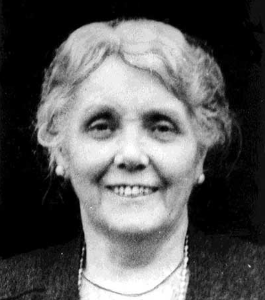Catherine Hogg Blair facts for kids
Quick facts for kids
Catherine Blair
|
|
|---|---|
 |
|
| Born |
Catherine Shields
8 January 1872 Byres Farm, Bathgate, Scotland
|
| Died | 18 November 1946 (aged 74) North Berwick, Scotland
|
| Nationality | Scottish |
| Other names | Catherine Blair Catherine Hogg Blair |
| Known for | Suffragette and founder of the Scottish Women's Rural Institute Establishing Mak'Merry Pottery Studio |
|
Notable work
|
Rural Journey: A History of the S.W.R.I. From Cradle to Majority |
| Parents |
|
Catherine Hogg Blair (born Shields; 8 January 1872 – 18 November 1946) was an amazing Scottish woman. She was a suffragette, which means she fought for women to have the right to vote. She also became a magistrate, a type of judge who handles minor cases. Catherine was the person who started the Scottish Women's Rural Institute (SWRI). She was also a member of the Women's Social and Political Union (WSPU), a group that worked hard for women's voting rights.
Catherine Blair cared deeply about women in the countryside. She wanted to help them in every way she could. In 1940, she wrote a book called Rural Journey: A History of the S.W.R.I. From Cradle to Majority. This book told the story of the SWRI and all it had achieved since it began in 1917. Besides her important work for women's rights, Catherine was also a talented artist. She was a potter and started her own pottery studio called Mak'Merry in MacMerry, East Lothian.
Contents
Catherine's Early Life
Catherine Blair was born on 8 January 1872 at Byres Farm in Bathgate, Scotland. Her parents were Susan Jemima Hogg and James Shields. Catherine was one of six children in her family. She went to school at Bathgate Academy. Later, her family moved to Dolphingstone Farm, near Tranent.
In 1894, Catherine met and married Thomas Blair, who was a farmer. After they got married, they moved to Hoprig Mains Farm, which was near Gladsmuir in East Lothian. Catherine and Thomas had four children together.
Fighting for Women's Right to Vote
Catherine Blair was a very active member of the Women's Social and Political Union (WSPU). This group was famous for its strong actions to get women the right to vote. Catherine led local meetings and wrote letters to newspapers to share her ideas.
She believed that strong actions were sometimes needed to make change happen. However, because she had a young family, she did not take part in the more extreme protests. Instead, she used her farm as a secret safe place. It was a refuge for Scottish suffragettes who had been let out of prison. This happened under a law called the Cat and Mouse Act. This law allowed sick prisoners to be released, but they could be sent back to prison later.
Catherine's husband, Thomas Blair, fully supported her work. He even quit his important role in the local Liberal party. He did this because he disagreed with how the government was treating the issue of women's voting rights. Catherine was also good friends with another suffragette named Nannie Brown. Nannie also worked with the Scottish Women's Rural Institutes.
In 1911, there was a national survey called a census. Catherine wanted to protest that women were often only recorded as "wife" on these forms. To show that she was an important person in her own right, she and her children moved to a nearby barn. This meant the census form had to list her as an individual, not just as someone's wife. Catherine's actions were part of a bigger protest by suffragette groups against the 1911 census.
Starting the Scottish Women's Rural Institute
In 1917, Catherine Blair saw that women in Scotland needed a group like the Women's Institutes that was starting in other places. So, she decided to create the Scottish Women's Rural Institute (SWRI). The very first meeting of the SWRI took place in Longniddry, East Lothian. Madge Watt from Canada was there, and 37 women joined the group that day.
The SWRI gave women in the countryside a chance to meet new people and share their skills. Catherine was very passionate about this. She understood that women often had many duties at home.
From the very beginning, Catherine suggested that the Scottish Women's Rural Institute should not just focus on home tasks. Instead, she wanted the group to give countrywomen a way to talk about their concerns. Housing was a very important topic for them. She believed that the future of Scotland depended on farming. And farming, she said, depended a lot on better housing and living conditions for people.
Even though the SWRI said it was not political, Catherine used the group to push for women's equality. She encouraged members to challenge the poor housing conditions in rural areas.
In 1919, Catherine Blair was involved in a special report called the Memorandum on Rural Housing. The Scottish Board of Agriculture asked for this report. It aimed to collect stories from women across rural Scotland about their housing experiences. The Board wanted ordinary members of the Scottish Women's Rural Institute to share what they needed and wanted in their homes.
Catherine Blair's Mak'Merry pottery studio was connected to the Scottish Women's Rural Institutes. Her pottery became very popular and was a special part of many country shows. When Catherine Blair passed away in 1946, people noted that her pottery was even sold in America. She also helped to create the Lothian Home Arts Guild of Craftswomen.
Later Life and Legacy
In 1921, Catherine Blair became a magistrate. This meant she could help make decisions in local courts.
Catherine Blair died in North Berwick on 18 November 1946.
In 2021, Catherine Blair was honored as one of many Scottish suffragists. Her story was included in a special deck of cards. These cards were given out as part of an education pack to 100 schools across Scotland.

